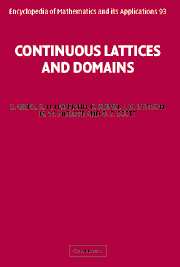Book contents
- Frontmatter
- Contents
- Preface
- Acknowledgments
- Foreword to A Compendium of Continuous Lattices
- Introduction to A Compendium of Continuous Lattices
- O A Primer on Ordered Sets and Lattices
- I Order Theory of Domains
- II The Scott Topology
- III The Lawson Topology
- IV Morphisms and Functors
- V Spectral Theory of Continuous Lattices
- VI Compact Posets and Semilattices
- VII Topological Algebra and Lattice Theory: Applications
- Bibliography
- List of Symbols
- List of Categories
- Index
II - The Scott Topology
Published online by Cambridge University Press: 13 August 2009
- Frontmatter
- Contents
- Preface
- Acknowledgments
- Foreword to A Compendium of Continuous Lattices
- Introduction to A Compendium of Continuous Lattices
- O A Primer on Ordered Sets and Lattices
- I Order Theory of Domains
- II The Scott Topology
- III The Lawson Topology
- IV Morphisms and Functors
- V Spectral Theory of Continuous Lattices
- VI Compact Posets and Semilattices
- VII Topological Algebra and Lattice Theory: Applications
- Bibliography
- List of Symbols
- List of Categories
- Index
Summary
In Chapter I we encountered the rich order theoretic structure of complete lattices and of continuous lattices. Wherever it was feasible to express statements on the level of generality of dcpos and domains we did so. Perhaps even more typical for these partially ordered sets is their wealth of topological structure. The aim of the present chapter is to introduce topology into the study – a program to be continued in Chapter III.
Section II-1 begins with a discussion of the Scott topology and its connection with the convergence given in order theoretic terms by lower limits, or liminfs. This leads to a characterization theorem for domains in terms of properties of their lattices of Scott open sets (II-1.14) – a type of theorem that will become a recurrent theme (see Chapter VII). One motivation for such considerations arises from the appearances of domain theory in theoretical computer science: one typically needs the generality of domains to model the structures and constructions under consideration, while continuous lattices enter the scene as their lattices of open sets.
In Section II-2 we determine that the functions continuous for the Scott topology are those preserving directed sups. We can thus express one and the same property of a function between dcpos either in topological or in order theoretical terms. The space [S → T] of all Scott-continuous functions between continuous lattices is itself a continuous lattice, and the category of continuous lattices proves to be cartesian closed.
Information
- Type
- Chapter
- Information
- Continuous Lattices and Domains , pp. 131 - 207Publisher: Cambridge University PressPrint publication year: 2003
